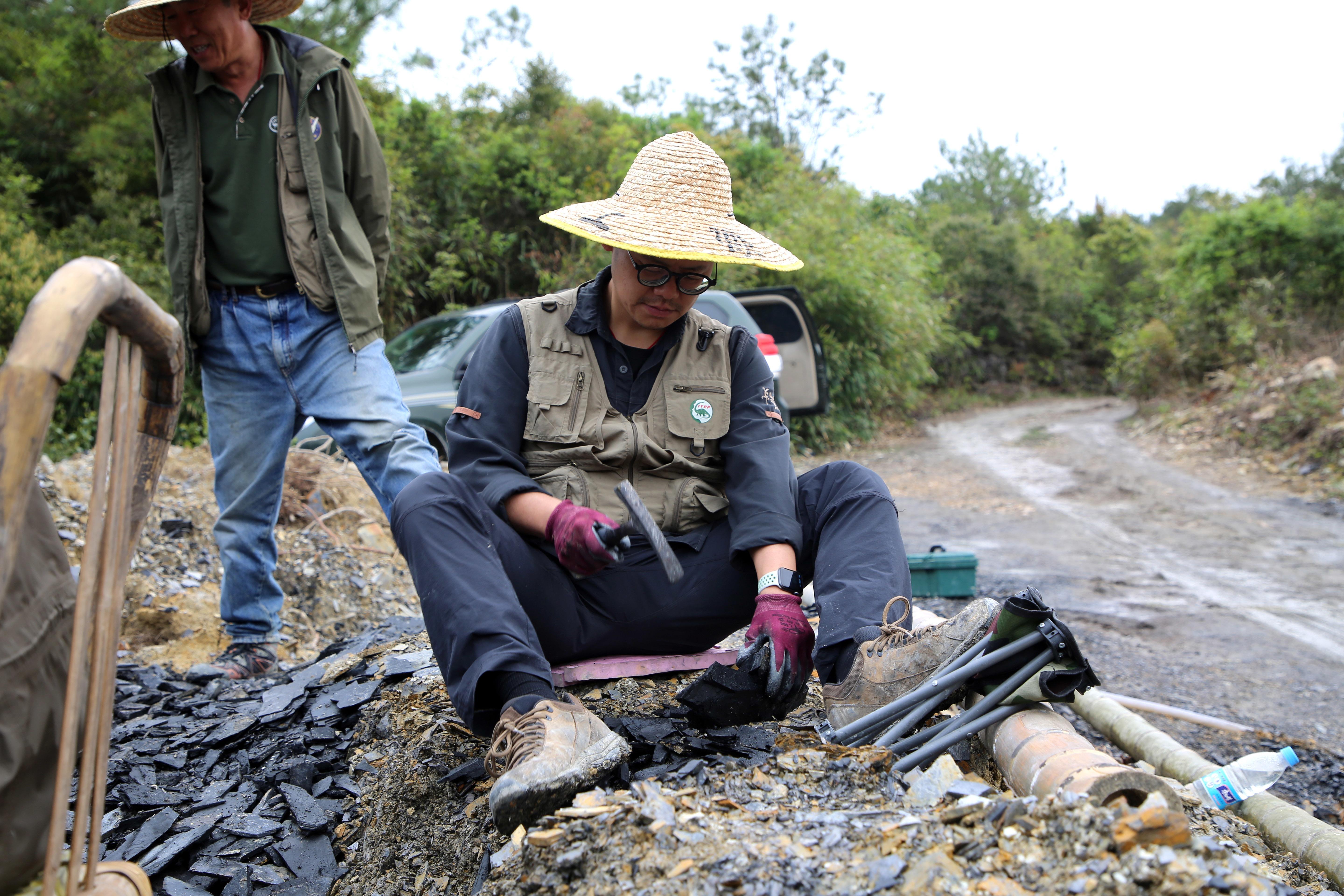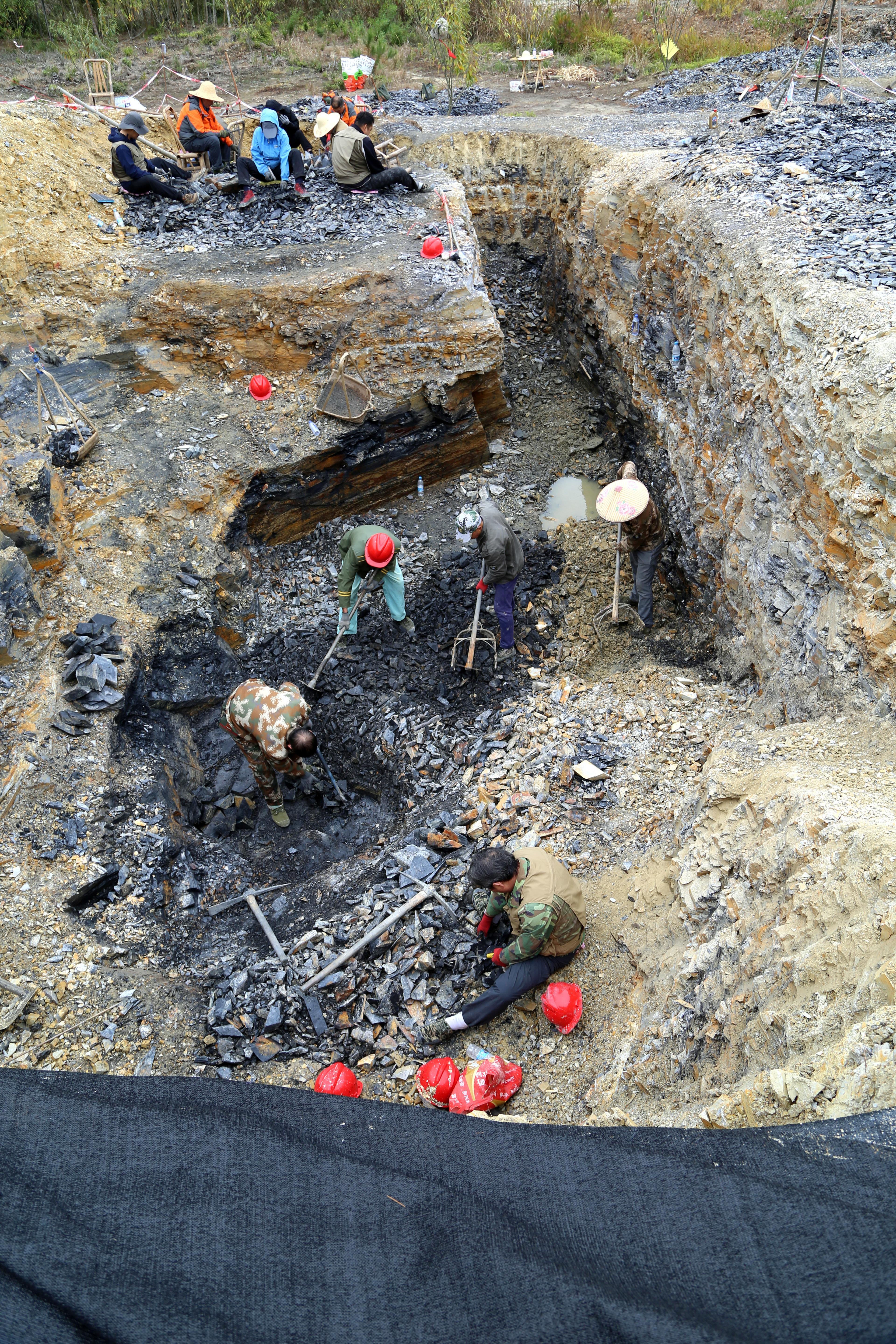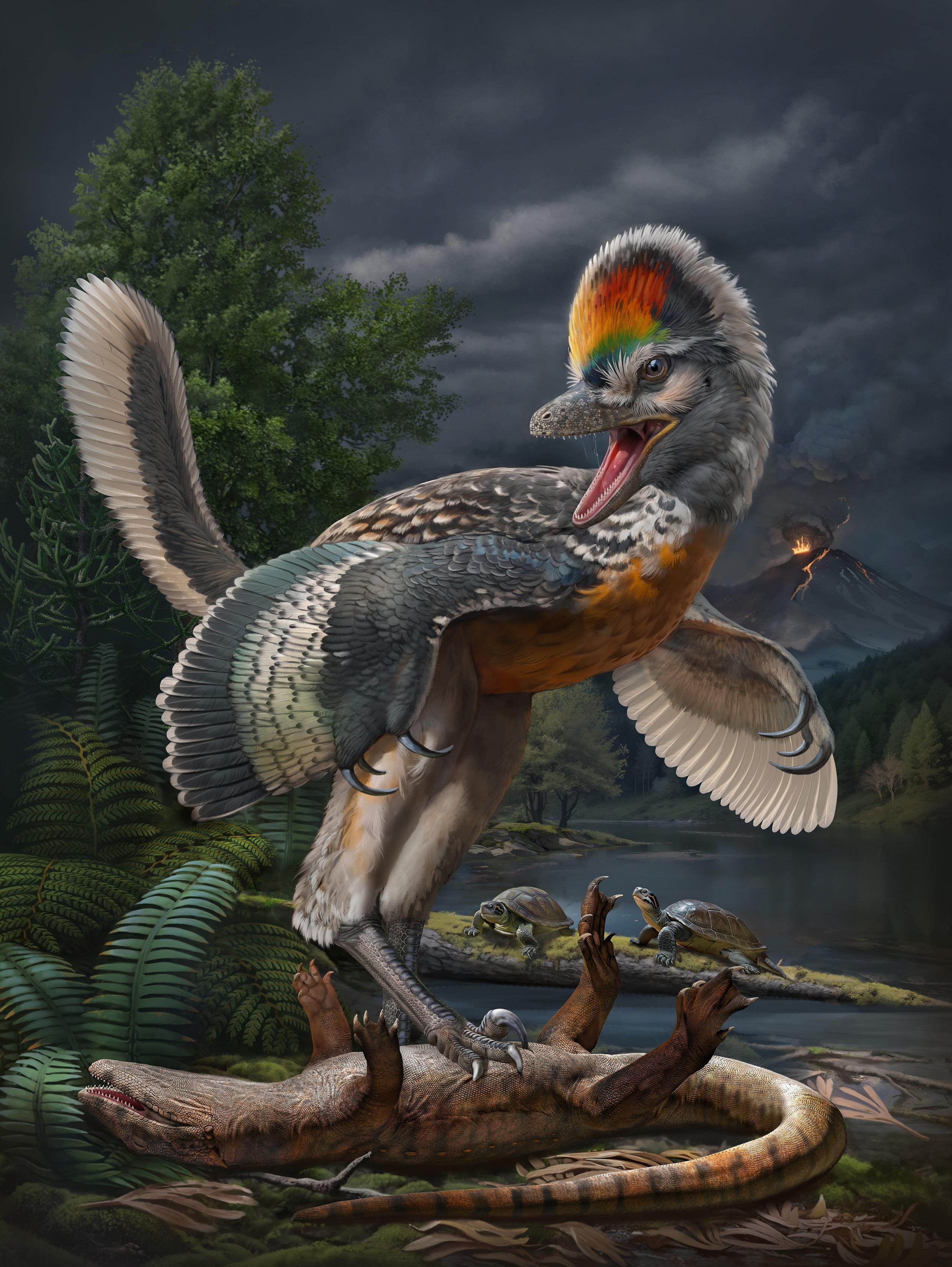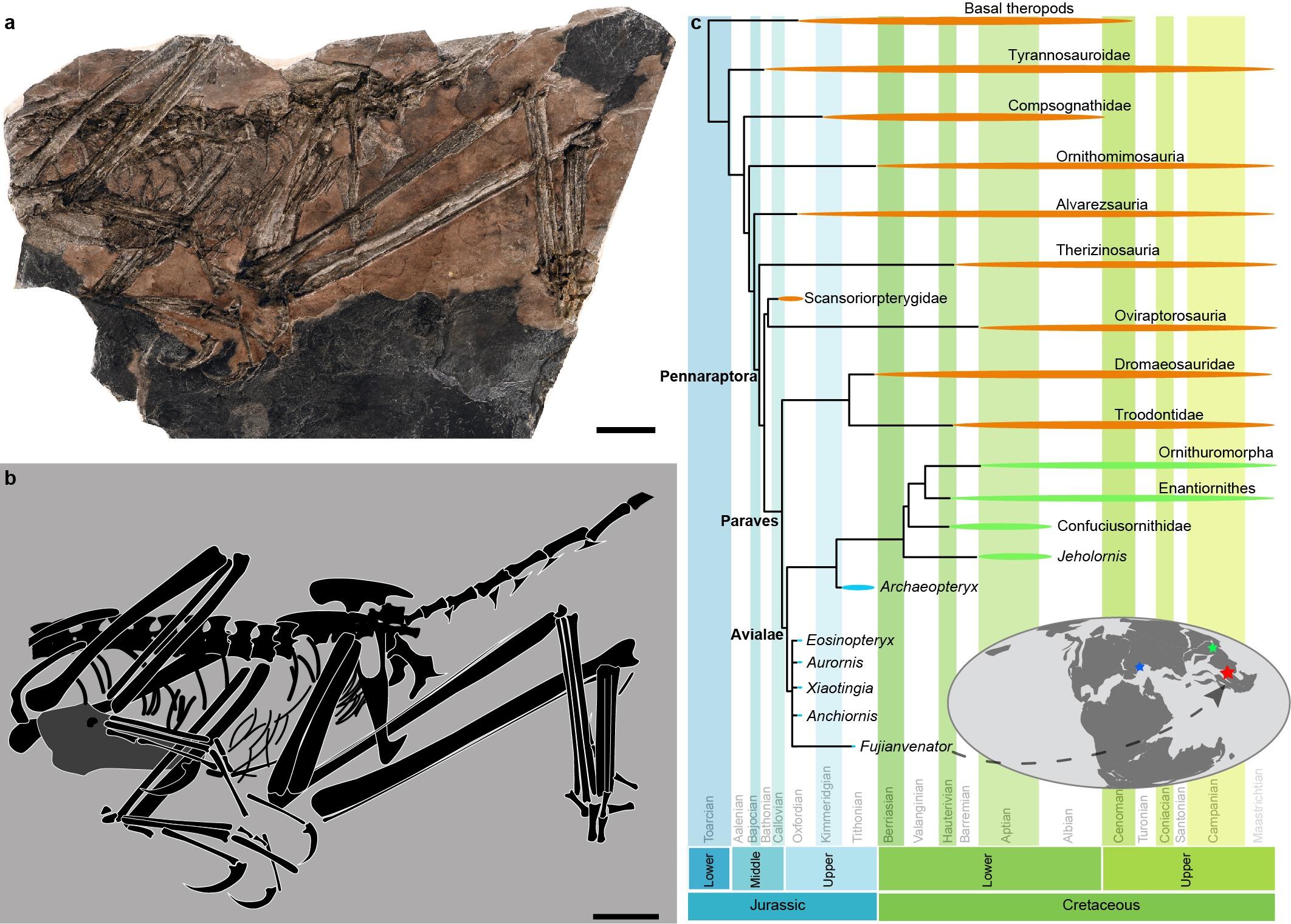Team of Chinese scientists discover fossilized remains of a new species of Jurassic-era bird, helping to fill a 30-million-year gap in existing avian records, Yang Feiyue reports.
 Wang Min at a field excavation in Zhenghe county, Fujian province. (PHOTO PROVIDED TO CHINA DAILY)
Wang Min at a field excavation in Zhenghe county, Fujian province. (PHOTO PROVIDED TO CHINA DAILY)
Approximately 150 million years ago, a birdlike dinosaur found itself fatally trapped in a long-vanished swamp in today's Zhenghe county in Nanping, in the eastern province of Fujian.
Its fossilized remains were unearthed last year by a group of Chinese scientists, who later proved it to be one of the earliest birds found so far from the Jurassic period, which ended about 145 million years ago.
The team named the new species Fujianvenator prodigiosus, and phylogenetic and radioisotopic dating analyses show that it branched off from the birdlike dinosaur family Anchiornithidae approximately 148 to 150 million years ago.
The description and analysis of the ancient fossil was published in leading international science journal Nature on Sept 6.
Birds are descended from non-avialan theropods (the most diverse group of "lizard-hipped" dinosaurs) from the Middle-Late Jurassic period. "Avialan" refers to the clade Avialae that includes all birds and their closest dinosaurian relatives, but the earliest phase of this evolutionary process from dinosaur to bird remains unclear, owing to a sparse fossil record.
"Jurassic avialans are key to deciphering the evolutionary origin of the avialan body plan. More importantly, they are key to reconciling the phylogenetic controversy about the origin of birds," explains Wang Min, who is from the Institute of Vertebrate Paleontology and Paleoanthropology at the Chinese Academy of Sciences in Beijing.
"Our understanding of the earliest evolution of Avialae has been hampered by the limited diversity of fossils from the Jurassic period," says Wang, who is also the lead and corresponding author of the new species study, which was conducted by the IVPP and the Fujian Institute of Geological Survey.
 Members of the Chinese Academy of Sciences and Fujian Institute of Geological Survey during a field study in Fujian. (PHOTO PROVIDED TO CHINA DAILY)
Members of the Chinese Academy of Sciences and Fujian Institute of Geological Survey during a field study in Fujian. (PHOTO PROVIDED TO CHINA DAILY)
To date, no definitive avialan fossils have been unearthed except at the Middle-Late Jurassic Yanliao Biota in Northeast China (166 to 159 million years ago) and the slightly younger Solnhofen Limestone in Germany (about 155 million years ago), which preserves the remains of the Archaeopteryx, the fossil publicly known as the "first bird". This leaves a gap of about 30 million years before the oldest known evidence of Cretaceous birds.
The appearance of the Fujian fossil fills in part of that gap in early bird evolution, according to Bhart-Anjan Bhullar, a paleontologist at Yale University in the United States.
"Even at their earliest stages, the closest fossil relatives of birds were diversifying in interesting ways," Bhullar was quoted in an article in Nature.
"There are many, many such things left to be discovered. We've only scratched the surface of the anatomical and lifestyle diversity of these animals."
The Fujian avialan fossil exhibits a bizarre assembly of morphologies shared with other avialans, as well as with some non-avialan carnivorous theropods, Wang says, adding that this shows the impact of evolutionary mosaicism (the mixture of ancestral and derived features in a single specimen) in early bird evolution.
"Our comparative analyses show that marked changes to body plan occurred along the early avialan line, largely driven by the forelimb, which eventually gave rise to typical bird limb proportions," Wang says.
"However, Fujianvenator is an odd species that diverged from this main trajectory and evolved bizarre hind limb architecture."
The fossil's surprisingly elongated lower leg and other morphologies, in combination with other geological observations, suggest that Fujianvenator lived in a swamp-like environment and was a high-speed runner or a long legged wader, indicative of a previously unknown ecology for early avialans.
 A rendering of Fujianvenator prodigiosus by Zhao Chuang; a group photo of researchers with the new fossil. (PHOTO PROVIDED TO CHINA DAILY)
A rendering of Fujianvenator prodigiosus by Zhao Chuang; a group photo of researchers with the new fossil. (PHOTO PROVIDED TO CHINA DAILY)
Wang has been extremely productive in the field of the origin and early evolution of birds, especially the way their features evolved across the bird-dinosaur transition during the Mesozoic era.
Since he began scientific research in 2014, he has helped name one third of all known birds found to date from the Mesozoic period, including the Archaeornithura meemannae that in 2015 was considered the most important discovery in a decade by the leading outlet for scientific news, commentary, and cutting-edge research Science, and the Ambopteryx longibrachium that made the cover of Nature in 2019.
Yet in his heart, the discovery in Fujian is his favorite because it was the first time that he led the team that dug it up.
Since October 2021, Wang's team and the Fujian Institute of Geological Survey have conducted several expeditions into multiple Mesozoic basins in Fujian.
Although they have found hundreds of vertebrate fossils, including fish, amphibians, and turtles, until recently, no traces of dinosaurs or birds were found, leaving them disappointed and anxious, with Wang even describing himself as being on the verge of losing hope. Then, on October 23 last year, he found himself standing in a 4-meter pit, holding the obsidian-black fossil of an avian corpse, beaming like a child.
"In the past, many of the important specimens I analyzed had already been prepared, but this one was different. I was there when it surfaced from the slab," Wang says.
"For most paleontologists, it's always a bit of a regret if you haven't personally excavated an important specimen," he adds.
Decades of geological surveys by the FIGS contributed greatly to this discovery.
In 2020, one of the most diverse Late Cretaceous dinosaur track sites in China was discovered in Fujian, which prompted a series of joint investigations by the Beijing and Fujian institutes.
 A graphic by Wang Ming charting the species, with a red star pinpointing the location of the Zhenghe Fauna. (PHOTO PROVIDED TO CHINA DAILY)
A graphic by Wang Ming charting the species, with a red star pinpointing the location of the Zhenghe Fauna. (PHOTO PROVIDED TO CHINA DAILY)
After failing to find dinosaurs in Xiapu county in Ningde, Wang and his colleagues decided to take a shot at Zhenghe county in Nanping.
By sheer luck, he unearthed the Fujianvenator prodigiosus fossil the first day of excavation at the new site. Although the skull is missing, this did not prevent the team from assessing the significance of the specimen.
Months have passed since the discovery, but Wang is still having difficulties reconciling its form.
The fossil's forelimbs are similar to an Archaeopteryx, while the pubis and ischium of its pelvis exhibit the typical features of the birdlike bipedal carnivorous dinosaurs, Troodontidae and Anchiornis huxleyi.
"It's like we have taken parts of the bones from different dinosaurs closely related to birds or avialans and then mixed them together to create a new animal," Wang says.
Its hind limbs are even more remarkable. In all non-avialan theropod dinosaurs, the thigh is longer than the shin, while in avialans, although the shin gradually became elongated, the degree of elongation was limited.
However, in the case of the Fujian fossil, the shin is twice as long as the thigh, a feature otherwise unknown among Mesozoic dinosaurs and birds.
In previous research, paleontologists believed that the key factor in the evolution from dinosaurs to birds was adaptation to tree-dwelling life. The shift meant that lower legs could not be too elongated, otherwise the bird would be unable to maintain its balance in the branches.
Fujianvenator's morphology indicates that it was likely a small theropod dinosaur that was an adept runner, or which lived near water.
"This lifestyle is completely different to the understanding in our community of ecological habits during the early evolution of birds," Wang emphasizes, adding that the discovery adds to the ecological diversity of primitive avialans.
Although Fujianvenator is eye-catching, scientists have found a great number of well-preserved animal fossils from the same part of Zhenghe.
"In addition to Fujianvenator, we have found an abundance of other vertebrates, including teleosts, testudines and choristoderes," says Xu Liming who is from the FIGS and who was lead author of the study.
 A drawing of the Fujianvenator prodigiosus and the fossil. (PHOTO PROVIDED TO CHINA DAILY)
A drawing of the Fujianvenator prodigiosus and the fossil. (PHOTO PROVIDED TO CHINA DAILY)
During the Late Jurassic-Early Cretaceous period, the area that is now southeastern China experienced intensive tectonic activity resulting from the subduction of the Paleo-Pacific plate, which created widespread magmatism and coeval fault-depression basins where the Fujianvenator was found, Xu explains.
This geological background is essentially the same as during the Late Jurassic in north and northeastern China, where the older Yanliao Biota is preserved, Xu adds.
"The extraordinary diversity, unique vertebrate composition, and paleoenvironment strongly indicate that this locality documents a specific terrestrial fauna, which we have named Zhenghe Fauna," says Zhou Zhonghe, who is attached to the Beijing institute, and co-author of the study.
In situ radioisotopic dating and stratigraphic surveys constrain Zhenghe Fauna to the period between 150 and 148 million years ago, which makes Fujianvenator one of the stratigraphically youngest, and geographically southernmost members of Jurassic avialans, Zhou says.
The discovery of Zhenghe Fauna opens a new window into the Late Jurassic terrestrial ecosystem, and the joint research team from the IVPP and FIGS plan to continue their exploration of Zhenghe and nearby areas.
Looking back on the period, Wang is thankful for his team.
"Everyone comes from different backgrounds with different personalities and habits. You can imagine how challenging it can be for a team of fifteen or more people to work and live together for over a month," Wang says.
"Some colleagues were experienced in fieldwork, and they always found ways to cheer the team up when we were frustrated."
Contact the writer at yangfeiyue@chinadaily.com.cn


